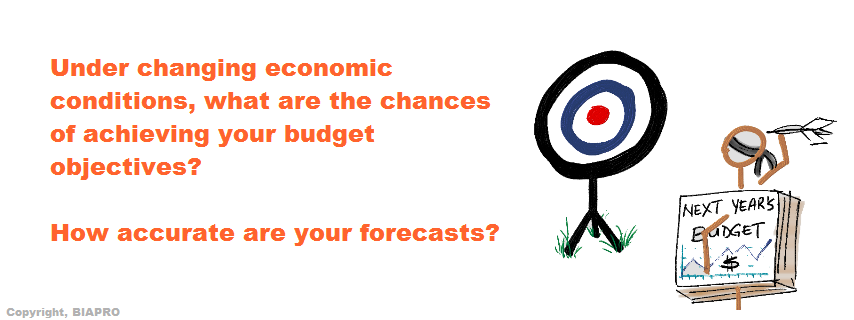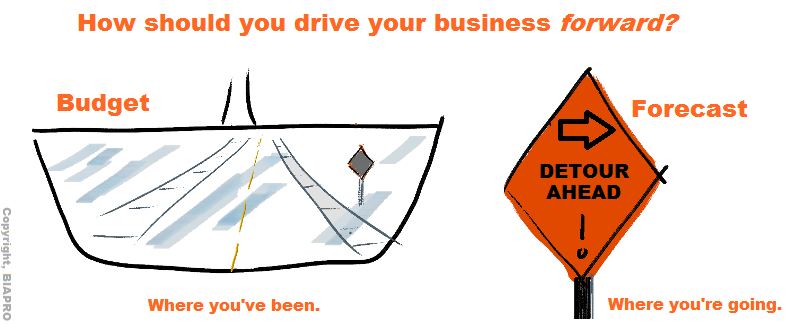
KPIs & Forecasts: Guaranteed Success
Generally, an organization's performance can be evaluated with very few Financial KPIs, such as: Revenues, Margins and Net Income levels. All of these would indicate the level of internal growth and profitability. Relative growth and profitability can be gauged by comparing these to the marketplace. To increase profitability, the need to keep track of operational KPIs is also a minimum requirement to gauge how well your organization is carrying out its business model. Each business model will have an implicit "resting level" for each of the operational KPIs, and they are not to be squeezed but managed. For example, the service level KPIs of a 5 star hotel will be very different, by design, to those of a road-side motel. The value propositions and business models can be substantially different even when looking at the same basic industry.
These KPIs tend to be analyzed across business segments, such as product and service lines, geographic regions, operational companies, or on a consolidated basis. Adding Traditional Budgets to the mix has only proven that budgets tend to be an unreliable management tool, creating more problems than solutions. Not only do Traditional Budgets create a sense of entitlement to the expense side of the equation, but it generally does a poor job of tying cause and effect together when corrective actions are required. How do we exactly increase sales? Is there an opportunity to improve Margins? How can we use the Traditional Budget to reasonably estimate the impact of initiatives on the KPIs we want to improve? Surprisingly, the best management tool is something we all tend to understand, especially when launching a new product or service: The Business Plan!
A basic Business Plan will generally have a business model that clearly ties the value proposition (what we are selling) to the operational aspect of delivering the value proposition (how will we deliver). A good business model therefore implicitly defines the cost base of our value proposition, and by establishing the selling price of the value proposition, perhaps with a marketplace comparative analysis, we automatically begin to get a sense of margins, net incomes and the underlying performance of our new or existing business.
This whole exercise is generally carried out from the very beginning to decide if the venture is worth carrying out at all! After a while, however, the Business Plan and business model slowly morph into a Traditional P&L Budget that was implicit in the previous years performance. Trying to manage a business with a budgeted P&L view of the business with previous conditions is like driving around with a GPS map that hasn't been updated since the very beginning. This Traditional Budget causes managers to lose touch with the underlying business model, and they are unable to make proper forecasts when attempting to incorporate new initiatives or evaluate permanent changes to the business delivery model.
In contrast, when expanding and tweaking the original business model by introducing temporary initiatives or permanent adjustments, the overall effect on the KPIs automatically becomes evident. This ultimately creates the basic management cycle of 1) plan, 2) define budget KPIs, 3) execute, 4) analyze, 5) learn & forecast.
As a result, one can agree that basic KPIs are sufficient to establish performance objectives, and by having well defined business models one can evaluate the expected effects of temporary or permanent adjustments to achieve those KPIs under changing conditions. With KPIs and corresponding business models, one can continuously manage business performance in any static or dynamic environment for an indefinite period of time. These tools implicitly incorporate a continuous change management process that allows the organization to never lose sight of its true KPIs and adjust initiatives or the business model itself in a conscious manner.
The result? Guaranteed Growth. Pure and Simple.
How to make use of KPI's and Forecasting
"To improve corporate performance, many organizations are starting to establish general annual budget metrics, while discarding the Traditional Budget and relying on more frequent, detailed, accurate and relevant forecasts to achieve those objectives."
Question:
There has been a lot of hype on managing organizations based on metrics and achieving budget objectives while discarding the Traditional Budget and implementing rolling Forecasts. What is your opinion on this? What can organizations expect to achieve with a BI365® platform designed, implemented and supported by BIAPRO ?
Answer:
The idea of having a business run itself solely on metrics or KPIs is extremely attractive and simplifies the management of the business. This is similar to our engine lights in our modern-day cars - if something goes wrong, they start blinking red and we rush to take the car to our mechanic for diagnosis and treatment.
However, it is important to note that, just like our car mechanic, in order to diagnose the specific cause of a problem indicated by a KPI blinking red, our business should have the ability to access the right analytical tools in order to shift through the many issues potentially causing the engine KPI to turn red.
To complicate matters further, businesses are also similar to ships on the high-seas, left to their own devices. They must have access to the diagnostic tools and the knowledge, or business intelligence, to help diagnose and correct the immediate danger indicated by the red blinking KPI. Knowing the symptom(s) does not necessarily tell you the cause of the problem and how to treat it. The ability to easily and quickly diagnose an apparent problem indicated by a KPI is something many organizations fail to implement, and as a result, minimizes the usefulness of any KPIs. It is not uncommon for organizations to invest in a KPI platform to then stop using it due to this oversight.
If a rolling forecast in an organization reflects the financial and operational values of a coherent business model under certain conditions, we will certainly facilitate the diagnosis as to why the KPI is blinking red. For example, if there is a problem with the bottom line, is it due to decreasing sales or higher than expected cost of sales? Perhaps, it may even be due to unfavorable exchange rates or higher HR costs due to overtime, and so on. Without a coherent forecasting model, diagnosing the cause is difficult, and unfortunately, one can't take corrective measures.
With this in mind, we generally suggest that organizations develop high level performance metrics or KPIs backed by a detailed underlying forecasting business-model. It is necessary to understand that a revised business plan, not a Traditional Budget, is being developed for next year's performance.
Traditional budgets, after all, are generally "rigged" to yield bottom line financial results expected by shareholders, without really understanding last year's numbers or next year's business performance implicit in the Budget Details. Traditional Budgets are also the mechanism that is used to set performance objectives that will determine whether management will earn their annual bonuses. All of these factors ultimately create problems for the business going forward, even though the bottom line looks fine.

Traditional Detailed line-item budgets may also give managers the wrong idea of being able to spend money allocated to them for certain expenditure types, with little or no emphasis on the direct return or expected benefit, for that expenditure or investment. The "intentional" mis-classification of actual expenses to align with traditional budgeted line-items is sometimes a temporary measure that is used to cover unforeseen or additional expenditures not originally contemplated in the budget. Unfortunately, budgets create an incentive for managers to conceal changing conditions from the organization going forward, and this can make the orgnization believe there is no immediate need to tweek or change the business model - planting the seeds for its own potential demise.
Moreover, most Traditional Budgets are the result of historical numbers, and do not necessarily reflect a full analysis of future performance objectives, as would a business plan would for a new venture. For this reason, it is important for organizations not to lose sight of the management cycle where forecasts should simply support budgeted KPIs. It is in the interest of the business to understand the changing conditions in the road ahead (or forecast), which could then be used to prepare better expectations and Forecasts for the following year.
A business that can do this is capable of aligning management behavior and shareholder value by clearly defining the Budgeted KPIs and creating a management culture that emphasizes the need to understand their business model that can better adapt to unforeseen challenges and opportunities. It is clear that an organization's past performance can be compared to the Traditional Budget, but it is not the way to drive the business forward. This is where simple budgeted KPIs and business-model forecasts are instrumental.
In the last few years we have witnessed many well-established and successful organizations fall prey to their own lack of forecasting processes when trying to follow a historically successful business model in a changed economic environment. Organizations like Kodak, Nokia and Blackberry come to mind.
In our own BI projects with clients, we have seen the power of implementing a forecasting process that is regular (1 to 3 months), which allows for the same sort of "budget or forecast" analysis while keeping the managers focussed on achieving the bottom line or some other operational or financial metric (i.e. KPIs).
In conclusion, success ultimately comes from changing the question from
"What was wrong with my actuals vs budget?" to
"What is changing in my business model and assumptions, and what do I need to contemplate in my forecast going forward to achieve my budgeted KPIs?".
As technical experts, not only can BIAPRO help organizations implement the required technology to enable Business Intelligence, but as Certified Management Consultants (CMCs) we can help organizations implement new management processes and methodologies to ensure their internal efforts are focussed on growing the business in a constantly changing economic environment.
If this sounds like something your organization can use to accelerate your growth, or if you have any questions, please contact us - we are looking forward to speaking about your particular situation and how we can help you Grow Your Business with BI365®: Business Intelligence. Everyday.
